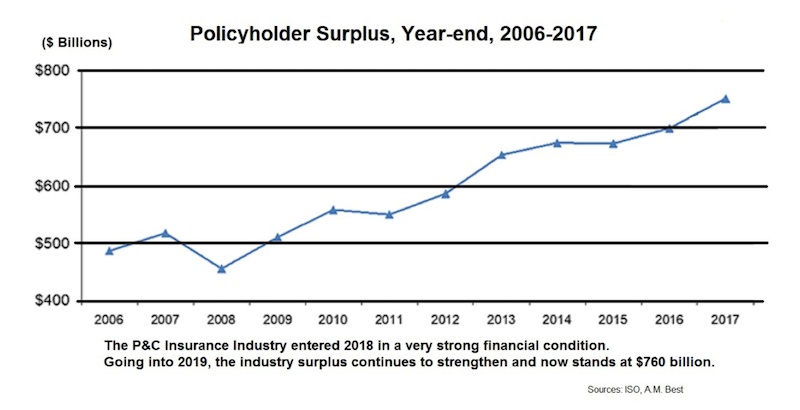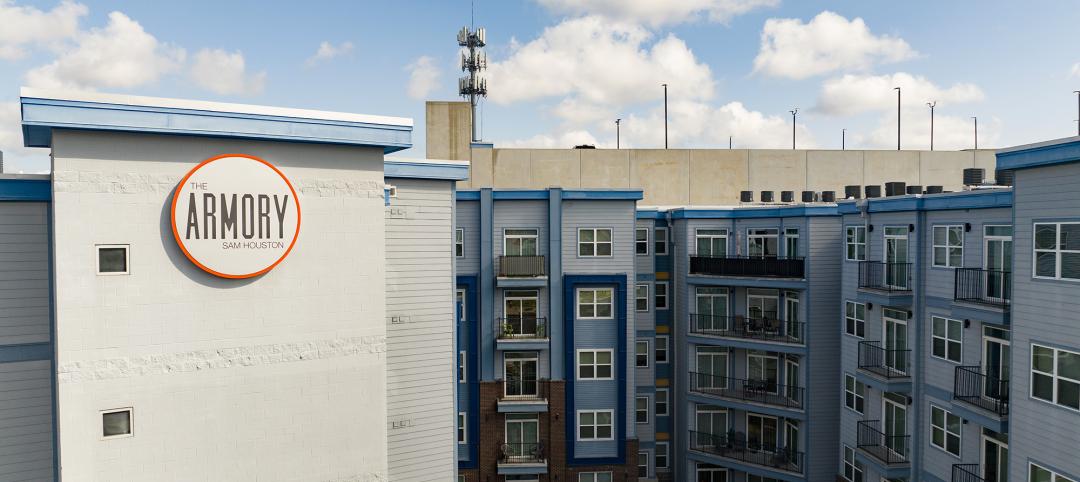The commercial property and casualty (P&C) market is driven by two powerful, albeit conflicting, forces: large catastrophic losses and excess capital. As a substantial part of real estate development is happening in areas exposed to floods, wildfires, severe storms, hurricanes and earthquakes, insurance companies are rethinking how to deploy their capital to manage aggregation in catastrophe exposed areas.
USI Insurance Services, a global insurance brokerage and consulting firm, recently released its 2019 Commercial Property & Casualty Market Outlook, which provides insight into the current dynamics of the property and casualty insurance market, as well as a deeper dive into covered sectors that include commercial real estate and construction, transportation, manufacturing/distribution, environmental, and aviation.
The report found a stable P&C industry in 2018, despite it having experienced five of the 15 costliest global catastrophes in the past two years, coupled with multiple large wildfires and other major loss events, which collectively caused in excess of $125 billion in total insured damages.
The P&C industry remains well capitalized, and its surplus now stands at $760 billion. Consequently, the industry has resisted significant and sustained market-wide rate increases, even as insured property losses from U.S. catastrophes alone went from $14.3 billion for 2.4 million claims from 33 catastrophes in 2010 to $101.9 billion for 5.2 million claims from 46 catastrophes in 2017, according to Property Claims Services and the U.S. Bureau of Economic Analysis.
It remains to be seen whether such restraint is sustainable if catastrophic events continue to increase and wreak havoc. USI says while most insureds should expect a flat to plus-5% rate change, but cautions that current rate trends will be difficult to maintain if the frequency and severity of catastrophes don’t abate.
The report notes specifically that pricing challenges are likely to persist in specific coverage lines such as property-exposed accounts in wind-prone areas, habitational risks, and large commercial trucking fleets.
Carriers, says USI, are also more likely to ask for moderate-to-high rate increases for many insureds in the public company directors’ and officers’ space, employment practices liability and medical malpractice for healthcare providers in certain classes.
Within the commercial real estate sector, multifamily properties could have the hardest time finding willing insurers. Beyond the natural catastrophe losses in 2017 and 2018, multifamily portfolios are producing fire and water damage losses, causing some carriers to either exit this risk class entirely, or increase rates and deductibles even for low-loss level insureds. With overall segment capacity shrinking, insureds with exposures to natural catastrophe and below average loss history can expect significant rate increases.
This could be especially true for frame construction, due to numerous large fire losses in recent years.

Despite the frequency of catastrophic events, insurers have so far resisted steady and high rate increases. Image: USI
The prospects are a bit brighter for nonresidential commercial properties, whose owners, developers, and managers have a distinct advantage, says USI: Quality risks remain the focus of carrier capacity offerings. Nevertheless, portfolios exposed to natural catastrophe will require a disciplined approach to achieve an optimal outcome in the marketplace.
USI joins other market observers in its expectation that spending on commercial construction will rise in 2019. Total construction spending may produce a 4% increase in insurance premiums in 2019, compared to 2018, while rates remain mostly flat in certain jurisdictions.
For larger construction projects, safety, specialization, timeliness, and staying within budget remain the biggest risks. “With good risk management and the use of Controlled Insurance Programs (CIPs), insureds can avoid disruptions, reduce loss costs, and meet expectations of all parties who have an insurable risk,” USI’s states.
Its report found in commercial construction a greater emphasis on jobsite safety to reduce claims per man-hour. The widespread application of BIM is fostering open collaboration and new ideas that are helping to mitigate risk, too.
USI also comments on the renewed interest in modular and prefabricated construction, which brings with it benefits of quality control and worker safety. However, those methods also raise insurance-related concerns, such as how a general liability insurance policy would respond to a potential claim, and how employees should be categories within their workers compensation programs.
Related Stories
Student Housing | Apr 23, 2024
Student Quarters selected to manage 502-bed student housing community
Student Quarters, a leading student housing owner and management company, announces the newest addition to its portfolio: The Armory Sam Houston Apartments.
75 Top Building Products | Apr 22, 2024
Enter today! BD+C's 75 Top Building Products for 2024
BD+C editors are now accepting submissions for the annual 75 Top Building Products awards. The winners will be featured in the November/December 2024 issue of Building Design+Construction.
Resiliency | Apr 22, 2024
Controversy erupts in Florida over how homes are being rebuilt after Hurricane Ian
The Federal Emergency Management Agency recently sent a letter to officials in Lee County, Florida alleging that hundreds of homes were rebuilt in violation of the agency’s rules following Hurricane Ian. The letter provoked a sharp backlash as homeowners struggle to rebuild following the devastating 2022 storm that destroyed a large swath of the county.
Mass Timber | Apr 22, 2024
British Columbia changing building code to allow mass timber structures of up to 18 stories
The Canadian Province of British Columbia is updating its building code to expand the use of mass timber in building construction. The code will allow for encapsulated mass-timber construction (EMTC) buildings as tall as 18 stories for residential and office buildings, an increase from the previous 12-story limit.
Standards | Apr 22, 2024
Design guide offers details on rain loads and ponding on roofs
The American Institute of Steel Construction and the Steel Joist Institute recently released a comprehensive roof design guide addressing rain loads and ponding. Design Guide 40, Rain Loads and Ponding provides guidance for designing roof systems to avoid or resist water accumulation and any resulting instability.
Building Materials | Apr 22, 2024
Tacoma, Wash., investigating policy to reuse and recycle building materials
Tacoma, Wash., recently initiated a study to find ways to increase building material reuse through deconstruction and salvage. The city council unanimously voted to direct the city manager to investigate deconstruction options and estimate costs.
Student Housing | Apr 19, 2024
Cal State Long Beach student housing project will add 424 beds
A new $115 million project recently broke ground at California State University, Long Beach (CSULB) that will add housing for 424 students at below-market rates. The 108,000 sf La Playa Residence Hall, funded by the State of California’s Higher Education Student Housing Grant Program, will consist of three five-story structures connected by bridges.
MFPRO+ News | Apr 18, 2024
Marquette Companies forms alliance with Orion Residential Advisors
Marquette Companies, a national leader in multifamily development, investment, and management, announces its strategic alliance with Deerfield, Ill.-based Orion Residential Advisors, an integrated multifamily investment and operating firm active in multiple markets nationwide.
Construction Costs | Apr 18, 2024
New download: BD+C's April 2024 Market Intelligence Report
Building Design+Construction's monthly Market Intelligence Report offers a snapshot of the health of the U.S. building construction industry, including the commercial, multifamily, institutional, and industrial building sectors. This report tracks the latest metrics related to construction spending, demand for design services, contractor backlogs, and material price trends.
Construction Costs | Apr 16, 2024
How the new prevailing wage calculation will impact construction labor costs
Looking ahead to 2024 and beyond, two pivotal changes in federal construction labor dynamics are likely to exacerbate increasing construction labor costs, according to Gordian's Samuel Giffin.

















